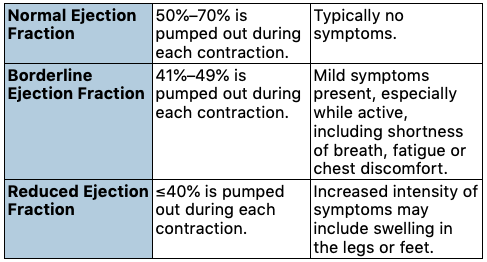
Maximize Your Heart Health: How to Improve Your EF
MARCH 08, 2023
By THE CORMEUM TEAM
Living with heart failure can feel like you’re constantly awash in a sea of acronyms and medical jargon. From knowing your BP (blood pressure) to understanding where you fall on the NYHAC (New York Heart Association Classification), the whole thing can be overwhelming, even anxiety-producing.
One acronym you’ll want to be familiar with as a heart failure patient is EF, which stands for ejection fraction. It’s important because this number (represented by a fraction) can help diagnose and monitor heart failure. Understanding EF and its significance in heart health can help you take proactive steps to improve your heart function and overall quality of life.
This post will demystify EF and explain its normal ranges. We’ll also recommend some steps you can take to improve your EF.
Now, let’s get to it — ASAP.
What Is Ejection Fraction?
According to the American Heart Association (AHA), “Ejection fraction (EF) is a measurement, expressed as a percentage, of how much blood the left ventricle pumps out with each contraction. … [EF] compares the amount of blood in the heart to the amount of blood pumped out. The fraction or percentage helps describe how well the heart is pumping blood to the body.”
To better understand why this percentage is so important, knowing how blood moves through the heart is helpful.
Blood enters the right side of the heart and is pumped to the lungs to receive oxygen. The left side of the heart receives the oxygenated blood from the lungs and pumps it out to the rest of the body. This process repeats with every heartbeat. In between beats, there is a pause when the left ventricle fills up with blood, ready to pump out or eject a portion of the oxygenated blood filling its chamber.
EF measures how effectively the left ventricle does this.
What Is a Normal Ejection Fraction?
A healthy heart has an EF of between 50% and 70%. Anything below 50% is considered abnormal and can indicate heart dysfunction. As heart failure worsens, your EF number decreases.

Heart Fact: Some patients with heart failure still register a normal EF. That is called HFpEF, another acronym that stands for heart failure preserved ejection fraction. You may have heard it referred to as diastolic heart failure. This is when the walls of your heart become thick and stiff and don’t allow the ventricle to fill with blood. So, even if 60% of the blood is being pumped out, the total amount of blood in the chamber is insufficient to meet the body’s needs.
What Causes Reduced EF?
Various factors, including high blood pressure, heart valve disease, heart attack, heart muscle disease and congenital heart defects, can cause a reduced EF. Aging, diabetes and obesity are also risk factors associated with reduced EF.
Can my EF be too High?
If your EF is above 70%, it could indicate hypertrophic cardiomyopathy, a genetic condition where the heart walls thicken.
Measuring EF
Your doctor can use several tests to determine your EF number. The most common is an echocardiogram (EKG). EKGs are non-invasive tests that use sound waves to produce images of the heart and calculate the amount of blood ejected from the left ventricle with each heartbeat.
Other non-invasive ways to measure EF are MRI, nuclear medicine test and CT scan. In some cases, your doctor may recommend cardiac catheterization. In this invasive test, a small tube is inserted into your blood vessel and threaded up to the heart, where measurements are taken.
Can You Improve Ejection Fraction?
If you’ve been to the doctor and your number isn’t quite where you want it to be, take heart (pun intended). Many people with low EF can improve their number.
According to the AHA, “By managing your heart failure carefully and following your treatment plan, you may be able to help yourself experience fewer symptoms and achieve a greater sense of well-being. As an added bonus, you may also see an improvement — or even a recovery — of your heart’s ejection fraction.”
Eat a Heart-Healthy Diet. Eating a diet high in fruits and vegetables and low in sodium can reduce fluid retention and decrease the workload on your heart. A healthy diet can also positively affect your health, like blood pressure, weight and energy levels. Consult with your health provider before starting any new eating regimen.
Exercise Regularly. One of the most common symptoms of heart failure is fatigue. This can make getting exercise challenging. But according to AHA, physical activity can help people with heart failure by “reducing symptoms, improving mood and even increasing the heart’s ability to pump blood.”
Your provider can help you determine how much and what exercise is best for you. Generally, aim for about 20 to 30 minutes of aerobic activity (like walking) most days of the week.
Watch Your BP, Etc. Conditions like hypertension (high blood pressure), diabetes and metabolic syndrome have all been linked as risk factors for heart failure. Managing the underlying conditions will help control your heart failure and improve your EF.
Ditch Unhealthy Habits. Alcohol, tobacco and recreational drugs can worsen heart failure symptoms. Cutting these habits out of your life, while not easy, can up your chances of improving your EF.
Manage Stress. “Just stop stressing out.” It’s easy to say but hard to do, especially when worried about your health. But stress has all sorts of side effects that harm your recovery. Practice stress management techniques such as meditation, yoga or deep breathing to reduce stress levels. You may also consider joining a support group with others who understand what you’re going through.
Use an App for Continued Success. Using a mobile app specifically designed for heart failure patients can help keep you on track toward improving your ejection fraction and overall heart health. Research shows that heart failure patients who use mobile apps to track their symptoms and lifestyle behaviors have better success with condition management and a lower risk of hospitalization. By using a mobile app to track these factors, you can actively manage your health and improve your quality of life.
The Heart of the Matter: Proactive Prevention
EF is one of the most essential acronyms to know and understand for heart failure patients. A healthy EF number is crucial for maintaining good heart health and improving the quality of life.
Whether you’re borderline or below, patients with low EF should be proactive in their preventative measures to maintain a healthy heart. Implementing healthy lifestyle changes and sticking with doctor-recommended treatments can stave off further deterioration, and, in some cases, you can see those EF numbers go up.

